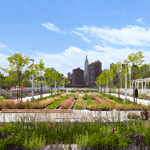When New York City’s Hunter’s Point South Waterfront Park opened along the banks of the East River in summer 2013, it was an instant hit with nearby residents hungering for green space.
With spectacular views of the Manhattan skyline across the river, the park was the first phase of a massive plan to revitalize the western-most portion of Queens, creating a community of five thousand moderate income apartments, a middle school and high school, and retail and office space.
The success of this waterfront park or any other is its two-way relationship with its urban context and more specifically, its community,” says Thomas Balsley, a landscape architect and founder of Thomas Balsley Associates, who designed the park and open space in collaboration with Weiss/Manfredi. (Story continues after the photo.)

The park’s “green oval” anchors its north end and acts as a lookout point across the river to Manhattan. Such vegetated areas are vital near waterways because they defend the city against flood damage. Photo: Albert VeČerka / Esto
PROJECT
Location New York City
Size 30 acres (master plan)
Completed 2013
Cost $66 million
TEAM
Architects Thomas Balsley Associates, Weiss/Manfredi
Client New York City Economic Development Corporation
Infrastructure Designer ARUP
Surrounded on three sides by water, Hunter’s Point wraps around the western tip of Queens providing a “green charm bracelet” for the emerging high-density urban area. The winding nature of the park made the most sense for the designers. “The shoreline could have been navigated in any number of ways,” Balsley says, “but this powerful curving promenade seems to unfurl from the green and spring toward the dramatic cantilevered overlook at the site’s highest promontory, where the views of the skyline are unmatched.”
“Activity vignettes”—basketball courts, a dog run, and an interpretive rail garden—are placed along the promenade based on proximity, size, and adjacent relationships. The largest of the spaces is the multiuse green oval that defines the site and offers iconic views directly across the river to Manhattan. “This green anchors the park’s north precinct and in turn is framed by pathways and a park pavilion that follows the curve of the oval,” says Michael Manfredi, cofounder of Weiss/Manfredi. (Story continues after the photos.)

The pavilion comprises two buildings underneath one continuous, pleated canopy, which supports 64 PV panels. Photo: Albert VeČerka / Esto

Photo: Albert VeČerka / Esto

Photo: Albert VeČerka / Esto
Because it needed to serve as a protective barrier from the ravages of devastating storms, the park posed a number of significant design and engineering challenges. “The waterfront site is both a place of recreation and relief from the urban core and a critical, hard-working, resilient perimeter,” explains Marion Weiss, the other founder of Weiss/Manfredi. “[It] is highly engineered to be the first line of defense for the surrounding community should severe flood conditions occur on the waterfront.”
Two years ago, the park’s engineering was put to the test as Hurricane Sandy wreaked havoc on the city. Smart streets with bioswales and a 760-foot partially submerged gabion wall along the shoreline worked to slow, capture, retain, and clean storm water, which reduced the load on the sewer system. Unlike other sections of the boroughs, the park fared well in the storm and suffered no significant damage. (Story continues after the photos.)

The master plan for Hunter’s Point shows its variety of activity spaces and the planned mixed-use development farther inland.

The following photos illustrate the variety of spaces and landscapes the park offers, including open space for running and playing and paths through wilder areas planted with native grasses. Photo: Wade Zimmerman.

Photo: Wade Zimmerman

Photo: Wade Zimmerman
Green
Certification Not applicable
Site Access to public transportation
Landscape Public park, acts as resilient barrier for urban core
Energy Roof-mounted photovoltaic panels
Water Rainwater collection valleys on roof of pavilion
Not only is the park virtually indestructible, but it also uses its abundant space for energy generation. More than 60 photovoltaic panels atop the on-site pavilion will generate upwards of 36,500 kilowatt-hours per year, powering 60 percent of the projected park demand. The pavilion canopy is designed to accommodate 64 additional solar panels, which would provide 100 percent of the park’s power requirements.
The park itself is meant to be a laboratory for sustainable, innovative thinking. This is particularly true of the plant material chosen for the project. Native trees along with shrubs, grasses, and perennials enrich the park’s planted areas, and most of the plants, selected for their hardiness in a brackish waterway environment, require little water.
The key to Hunter’s Point Park’s success is how it relates to the diverse community it serves, and its program makes a definitive statement in ecological design. In Balsley’s words: “The result is a park experience enriched with cultural and ecological narratives—robust sustainability expressions of infrastructure, landscape, and architecture.”

